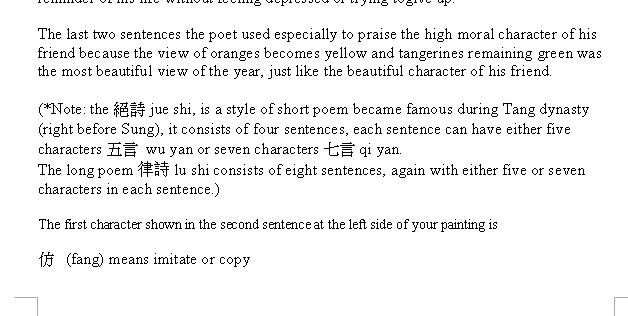Posted By: pK
Posted Date: Oct 16, 2010 (01:02 PM)
http://www.haoshici.com/Sushi432.html
蘇軾 (蘇東坡)
贈劉景文
荷盡已無擎雨蓋,
菊殘猶有傲霜枝。
一年好景君須記,
最是橙黃橘綠時
The two sentences (with seven characters in each sentence) shown at the right-hand side of your painting are the last two sentences of a 7-character short poem七言絕詩 (qi yan jui shi), titled “For Liu Jing Wen” 贈劉景文 , written by the famous Northern Sung poet, 蘇軾 Su Shi or 蘇東坡 Su Dong Pou in 元佑五年 1090 A.D.
The poem described the late fall and early winter scenery in his poem which can be translated as:
“Lotus (Nelumbo) withered with their seed heads gone,
Yet rotted mums (chrysanthemum) remained with their branches whole,
Remember you must, the best view of the year,
is no other than the time when oranges were still yellow and tangerines were still green.”
The poet, Su, gave this poem to his friend. Liu, to remind him that although his friend’s life might seem to be at the end of his journey (just like winter), yet looking back he should have no regret because he had already accomplished a lot (like harvesting at the end of Fall) and therefore although he was no longer young, he should treasure the reminder of his life without feeling depressed or trying togive up.
The last two sentences the poet used especially to praise the high moral character of his friend because the view of oranges becomes yellow and tangerines remaining green was the most beautiful view of the year, just like the beautiful character of his friend.
(*Note: the 絕詩 jue shi, is a style of short poem became famous during Tang dynasty (right before Sung), it consists of four sentences, each sentence can have either five characters 五言 wu yan or seven characters 七言 qi yan.
The long poem 律詩 lu shi consists of eight sentences, again with either five or seven
characters in each sentence.)
The first character shown in the second sentence at the left side of your painting is
仿 (fang) means imitate or copy
That means the artist was copying an original painting painted by 華嵒 Hua Yan, also known as
新羅山人 or 華秋岳 (1682-1756), a painter in the Qing dynasty (around Emperor
康熙 Kang Xi era).
Some original painting made by Hua can bee seen here:
http://big5.sc001.com.cn/trade.sc001.com.cn/showimg/85383.html#img1
There is one Chinese character executed in草書 Cao Shu (cursive script) between the above characters and the name of possibly the painter of this painting -周漢生 Zhou Han Sheng. I cannot confirm what it is, it can either be Wan or Hua, both can be Chinese surnames. It is not uncommon for Chinese married women to use their husband’s surname right in front of their own maiden name which will end up with a Chinese name with four characters. However, the name Zhou Han Sheng is usually used for males and therefore this extra cursive character (different than other standard scripts) placed right before the name of the presumed artist of your painting is a mystery to me.
Not too much can be found about Zhou Han Sheng, there is only one Chinese artist with that name could be found:
http://tc.wangchao.net.cn/baike/detail_1984763.html
This Zhou Han Sheng was born in 1942, graduated from the Canton Academy of Industrial Arts in 1966, studying the techniques of carving bamboo of Ming/Qing dynasty and became one of the distinguished bamboo carving experts during the 70s in China. He has also served as assistance professor at the 武漢江漢大學藝術系 http://www.jhun.edu.cn/
May be you can contact him and see if he was the one who did your painting.
Good luck.
PK
P.S. By the way, something is wrong with your e-mail address.


